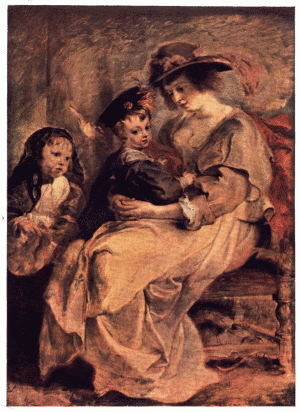It was during his stay in London that he painted the picture now in the National Gallery, called Peace and War (No. 46). This was intended as an allegory representing the blessings of peace and the horrors of war, which he presented to the king as a tangible recommendation of the pacific measures which he had come to propose. After the dispersion of the Royal Collection during the Commonwealth this picture was acquired by the Doria family at Genoa, where it was called, oddly enough,Rubens's Family. As a matter of fact the children are those of Balthazar Gerbier. He
also painted the S. George and the Dragon,oil painting for sale, which is now at Windsor Castle, and made the sketches for the nine pictures on the ceiling of the Banqueting Hall—now the United Service Institution Museum—in Whitehall. It was on this occasion, too, that he received the honour of knighthood from Charles I., who is said to have presented him with his own sword.
also painted the S. George and the Dragon,oil painting for sale, which is now at Windsor Castle, and made the sketches for the nine pictures on the ceiling of the Banqueting Hall—now the United Service Institution Museum—in Whitehall. It was on this occasion, too, that he received the honour of knighthood from Charles I., who is said to have presented him with his own sword.
In the following year, 1630, Rubens married his second wife, Helena Fourment, who was only sixteen years old—he was now fifty-two or fifty-three. She belonged to one of the richest and most respectable families in Antwerp, and was by no means unworthy of the compliment of being painted in the character of the Virgin receiving instruction from S. Anne, in the picture which is still at Antwerp. art oil paintings online
In 1633 his painting was again interrupted by a diplomatic mission, this time to Holland; and his remaining years were subject to more distressing interruptions, from the gout, to which he finally succumbed in 1640.
When we come to consider the English School of painting we shall see how much of its revival in the middle of the eighteenth century was due to the personality as well as to the genius of Sir Joshua Reynolds. In the Netherlands, likewise, it was not merely a great painter that was required to raise the art to life, but a great personality as well; and to the influence of Rubens may be attributed much if not all of the extraordinary fertility of the Flemish and Dutch Schools of the seventeenth century. Making every allowance for the difference in the times in which the Van Eycks and Rubens were working, there is no doubt that the former lived in too rarefied an atmosphere ever to influence their fellows, and with the exception of Hans Memling they left no
PLATE XXIV.—RUBENS
PORTRAIT OF HÉLÈNE FOURMENT, THE ARTIST'S SECOND WIFE, AND TWO CHILDREN
Louvre, Paris
PORTRAIT OF HÉLÈNE FOURMENT, THE ARTIST'S SECOND WIFE, AND TWO CHILDREN
Louvre, Paris
one worthy to carry on their tradition. Rubens showed his contemporaries that art was a mistress who could be served in many ways that were yet unthought of, and that she did not by any means disdain the tribute of other than religious votaries. Beginning, as we have pointed out, with sacred subjects, Rubens soon turned to the study of the classics, and found in them not so much the classical severity that Mantegna had sought for as the pagan spirit of fulness and freedom. "I am convinced that to reach the highest perfection as a painter," he himself writes "it is necessary, not only to be acquainted with the ancient statues, but we must be inwardly imbued with the thorough comprehension of them. An insight into the laws which pertain to them is necessary before they can be turned to any real account in painting. This will prevent the artist from transferring to the canvas that which in sculpture is dependent on the material employed—marble, for instance. Many inexperienced and indeed experienced painters do not distinguish the material from the form which it expresses—the stone from the figure which is carved in it; that which the artist forces from the dead marble, from the universal laws of art which are independent of it. buy oil paintings online

No comments:
Post a Comment